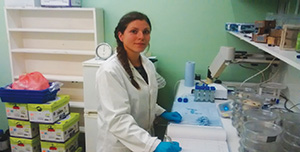
Imagine a world where the effects of drinking a beer never wear off because the human body can’t break down the alcohol and eliminate it. As a person drinks more beer, the alcohol in their blood builds up to higher and higher levels – it bioaccumulates. In this world, even occasional beers could kill.
What does this have to do with bees? It turns out that some insecticides can also bioaccumulate, which can greatly increase the duration of their toxicity to bees, thereby increasing their risk. This is the topic for our sixteenth “Notes from the Lab,” where we highlight “Fipronil pesticide as a suspect in historical mass mortalities of honey bees,” written by Philippa Holder and colleagues and published in the journal Proceedings of the National Academy of Sciences of the United States [115:13033-13038 (2018)].
Holder and colleagues’ study was inspired by two main observations. First, between 1994 and 1998, there were several instances of mass honey bee colony deaths near agricultural areas in France. Second, French farmers (especially sunflower growers) started to use two new insecticides at this time. Fipronil, a phenylpyrazole insecticide, was introduced in 1993, and imidacloprid, a neonicotinoid insecticide, was introduced in 1994. Both fipronil and imidacloprid are systemic insecticides, meaning they can be taken up by any plant and incorporated into pollen and nectar. Thus, there’s substantial risk of exposure to pollinators, including honey bees.
As most readers of this column will know, there’s been a large body of work over the past decade or so on risk to bees from neonicotinoid insecticides, including imidacloprid. This work includes speculation that imidacloprid was the culprit for acute losses of honey bee colonies in France in the mid-1990s. However, most exposure data show that imidacloprid levels in pollen, nectar and honey are generally quite low – on the order of a few parts per billion. These low-level exposures are not good for bees, of course, but there’s little evidence they’re sufficient to cause acute mass die-offs of colonies.
On the other hand, there is reason to suspect that fipronil can potentially cause colonies to fail at similar low-level exposures. Why? While honey bees can rapidly metabolize and detoxify parts per billion levels of imidacloprid, they may have less ability to do so with fipronil. This could explain why the 10-day LD50 of honey bees for imidacloprid is 123 nanograms per bee (ng/bee), but the 10-day LD50 for fipronil is only 3 ng/bee. With these data in mind, Holder and colleagues set out to test whether fipronil could in fact bioaccumulate in bees, how this impacts its toxicity compared to imidacloprid, and how the viability of full honey bee colonies might be affected.
So, what did they find? Did fipronil bioaccumulate in bees? In the laboratory, Holder and colleagues found that nearly all of the highly toxic sulfone metabolite of fipronil persisted in bees for at least 6 days. In contrast, >90% of imidacloprid is typically excreted from honey bees within ….


